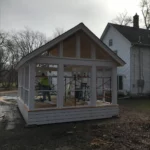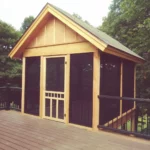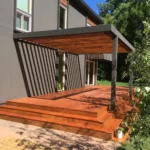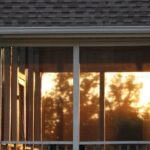Deck floor covering ideas are crucial in creating functional and aesthetically pleasing outdoor spaces. Whether you have a patio, deck, or balcony, the right flooring option can transform your space into an inviting place for relaxation and entertainment. From conventional wood decking to interlocking tiles and vinyl flooring, choices suit different preferences and budgets.
This article will explore 10 deck floor covering concepts that are durable, easy to install, waterproof, and cost-effective. It will help you find the perfect solution for your outdoor area. Keep reading to learn more.
Top 10 Outdoor Deck Floor Covering Ideas
Are you in search of the perfect outdoor deck floor covering? With so many options available, it can take time to decide. That’s why we’re here to help!
Our ultimate guide will guide you through the top 10 outdoor flooring ideas for your deck, ensuring you find the best option for your needs.
-
Composite Decking
Composite decking is a reliable outdoor flooring option for your deck. It offers multiple benefits, making it a popular choice among homeowners.
One of the leading edges of composite decking is its durability. It can resist heavy foot traffic and extreme weather conditions without splintering or rotting like natural wood.
Another advantage is that composite decking requires minimal maintenance compared to traditional wood decks. You won’t have to worry about regularly staining, sealing, or sanding the surface. Clean it with soap and water when needed.
What sets composite decking apart from raw wood is its eco-friendly nature. Made from recycled materials like plastic bags and sawdust, this flooring helps reduce waste. At the same time, it offers an appealing look for your outdoor area.
Regarding aesthetics, composite decks come in various colors to suit different design preferences. From classic browns to contemporary grays, you can find a shade that seamlessly complements your home’s exterior.
Although composite decking has many advantages over natural wood options, it initially comes at a slightly higher price point. However, investing more upfront guarantees long-term savings on maintenance costs. That’s because wooden decks require more frequent upkeep over time.
-
Outdoor Tile
The resemblance of outdoor tile to other materials like stone, wood, or brick adds an aesthetic appeal. At the same time, it’s more durable and cost-effective.
One popular choice in this category is quarry tile, which replicates the look of terra cotta or brick. It features a non-porous surface and enhanced durability compared to traditional options.
Quarry tiles also provide excellent traction for decks, seating areas, and walkways. They are designed to withstand the elements and offer long-lasting performance.
-
Traditional Wood Decking
Classic wood decking is one of the most affordable options for outdoor wood flooring. Different types are available, such as pine and cedar, each offering durability and appearance.
The pros of traditional wood decking include its ease of installation and affordability. Additionally, it provides a rustic, natural aesthetic with various material choices available.
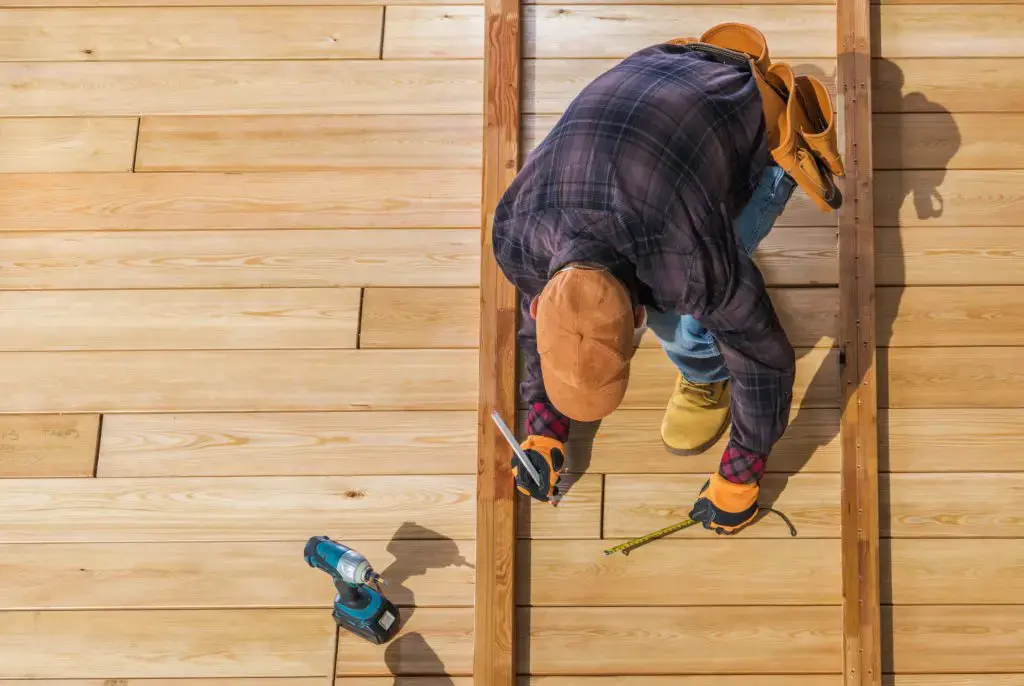

On the other hand, there are some drawbacks to consider when choosing traditional wood decking. Consistent cleaning, polishing, and staining maintenance is required for proper upkeep.
Depending on your location’s weather conditions, pressure-treated treatment may also be necessary. That’s because this type of deck isn’t very resistant or durable against harsh elements.
When properly maintained, traditional wooden decks can last 10-15 years. Quality impacts longevity, but consistent care can extend their lifespan even further.
-
Poured Concrete
Poured concrete offers an affordable and durable solution for outdoor flooring. Unlike pavers, which come in different shapes and sizes, poured concrete is laid out in long slabs that are poured and cured on-site.
One advantage of poured concrete is the ability to stamp it with unique patterns before it cures. This ability gives your deck a one-of-a-kind look and offers versatility compared to other materials like bricks or tiles. It is water, fire, and corrosion-resistant and easy to clean—a simple sweep often does the trick!
While highly cost-effective upfront, poured concrete does have its drawbacks over time. The slabs may buckle or crack as they age, requiring maintenance that can be tedious compared to other options like concrete pavers.
It also bears mentioning that repairing cracked concrete can be challenging. Moreover, walking on this hard surface might feel uncomfortable, especially barefoot, during cold weather.
Also, improper sealing may make them prone to mold growth if not correctly sealed after curing.
-
Concrete Pavers
Concrete pavers are a durable and stylish option for your outdoor deck. You can customize your deck with various sizes and styles to fit your aesthetic preferences. Unlike poured concrete, which is mixed on-site, pavers are pre-made and easy to install.
One advantage of concrete pavers is their ease of maintenance. If an individual tile gets damaged or cracked, it can be easily replaced without redoing the entire area. Additionally, they are slip-resistant and resistant to stains caused by spills or weather elements.
In terms of durability, concrete pavers surpass poured concrete due to their ability to handle heavy loads per square inch. They are also water-, fire-, corrosion-resistant, and free from VOCs (volatile organic compounds).
Nevertheless, frequent weed intrusion may require additional cleaning efforts if these are not correctly laid. Otherwise, it may need professional help over time since mechanical stability might be compromised.
Though initially expensive, their long-term viability helps make them more cost-effective than poured concrete flooring. It’s important when choosing materials for high-traffic areas or areas where heavy outdoor furniture will be placed.
-
Porcelain Tile
Porcelain is a highly recommended outdoor flooring option that can give your deck a modern and sophisticated look. One of the significant advantages of porcelain is its exceptional durability, thanks to being clay-fired at high temperatures over 1200º F.
Although porcelain tiles are lighter than stone, concrete, or brick, cutting them precisely may require professional equipment.
Porcelain offers numerous benefits, such as weather resistance, stain resistance, and mold- and water-resistant—making it an ideal choice. Moreover, it is long-lasting and has easy maintenance requirements—clean them when needed.
However, it comes at a higher cost than other ceramic options.
Besides, due to their distinctive characteristics, they have certain other downsides. Porcelain might be heavier than ceramic and require additional structural support during installation.
We shouldn’t use traditional implements to provide precise fitting during installation. It demands technical proficiency and engaging professionals.
Moreover, the price tag associated with these floorings, albeit justified by undeniable quality, could put some people on track. Hence, one should always consider the budget before making any decision.
-
Ceramic Floor Tile
Ceramic outdoor flooring is a cost-effective option compared to porcelain, even though it may not be as durable. Its installation is more straightforward because of its lighter weight and easier cutting process.
There are numerous choices available with ceramic tiles. This includes various colors, patterns, and shapes that can improve the aesthetic charm of your outdoor space. Cleaning ceramic tile is relatively hassle-free, making it suitable for areas with high foot traffic.
However, it’s important to note that ceramic tile has its drawbacks. This material tends to crack more quickly than some alternatives. Moreover, it is porous, making it susceptible to mildew, mold growth, and water damage.
-
Outdoor Vinyl
Outdoor vinyl flooring is another durable, low-maintenance option for your covered deck or patio. It’s easy to clean and immune to scratches and stains, ensuring it maintains its appearance over time. The synthetic materials used in outdoor vinyl make it water-resistant or even waterproof. Hence, it’s perfect for areas exposed to the elements.
While outdoor vinyl can resemble natural stone or wood, it may have a different authentic look than genuine materials. However, what it lacks in authenticity, it makes up for with comfort underfoot when compared to more complex surfaces like stone or tile.
When considering outdoor vinyl flooring options, be aware that constant exposure to the weather can reduce its durability. Additionally, some kinds of outdoor vinyl may contain VOCs (Volatile Organic Compounds). Hence, keep this in mind if you have sensitivities.
-
Plastic Deck Tiles
Plastic deck tiles are a practical choice for outdoor areas exposed to water. These tiles offer slip resistance and built-in drainage features, making them resistant to mold and mildew. They also have the added benefit of being fade-resistant. That means they won’t change color from extended sun exposure.
Another advantage of plastic deck tiles is their versatility in colors and patterns due to their synthetic material. Installation is usually straightforward, requiring minimal effort for maintenance.
However, it’s important to note that these tiles can feel rigid underfoot compared to other options. Additionally, some individuals might find the synthetic appearance not aligned with their style preferences.
-
Artificial Turf
Also known as synthetic grass, artificial turf is a unique and low-maintenance option for outdoor flooring in backyards. It has a textured surface that mimics the look of natural grass. Hence, it adds a touch of natural beauty to any space. Installation is easy and hassle-free.
One of the noteworthy advantages of artificial grass is that it requires little to no maintenance. Unlike natural grass, there’s no need for watering or mowing. This saves time, reduces water usage, and lowers your bills.
Another benefit is its durability. Most artificial turfs are designed to resist heavy foot traffic without displaying symptoms of wear and tear. Additionally, they retain their vibrant green color over time due to their resistance to fading from sunlight exposure.
However, one limitation of artificial turf is that there are limited options for growing trees or plants directly into the ground since cutouts would be required instead. Therefore, it’s best suited for large open areas where additional planting is optional.
What Type of Flooring Is Best for Your Outdoors?
When it comes to outdoor flooring, the best type depends on your personal preferences and budget. If durability is essential, options like composite decking or stone tiles are excellent. They provide long-lasting guards against wear and tear from the elements.
These alternatives offer a stylish solution for those concerned about poured concrete surfaces. Ultimately, every option listed above has merits and is worth considering for creating a beautiful outdoor room that suits your needs.
What Is the Best Covering for Old Decks?
Several options are available for covering up an old deck and giving it a fresh look.
- One of the best choices is wooden design interlocking deck tiles. They are easy to install and come in various wood designs, adding a touch of elegance to your outdoor space.
- Composite decking is another favored option, as it provides a modern appearance while covering up the old surface.
- For those looking for something more traditional, replacing the old boards with new ones can do wonders for revitalizing an aging deck.
- Deck Rite floor covering is also worth considering, as it offers durability and style in one package.
- If you’re after comfort and uniqueness, artificial turf interlocking tiles provide a soft surface underfoot.
- Power washing followed by staining and sealing can give your tired-looking deck a much-needed facelift without extensive renovations. It’s affordable, too.
- Another cost-effective option is applying fresh paint, which can instantly transform an outdated space into something vibrant.
- Consider using Big Floors DuraGrid Outdoor Interlocking Plastic Deck Tiles if ease of installation and long-lasting reliability matter most to you. These durable tiles will check both boxes!
- Lastly, pavers are sturdy yet attractive coverings that stabilize any ground material surrounding your old decks.
What Is the Cheapest Type of Outdoor Flooring?
For affordable options, poured concrete is one of the cheapest types of outdoor flooring. It offers durability and easy maintenance, but be cautious as it can develop cracks over time. Another inexpensive option is laminate flooring for your outdoor deck. Plus, installation is a breeze!
Most Slip-Resistant Outdoor Flooring
Outdoor flooring options vary in slip resistance, with several choices standing out for their excellent performance.
- One standout option is outdoor sports tiles, known for their firm grip even when wet.
- Rubber pavers and artificial turf also provide exceptional slip resistance, as does outdoor carpeting.
- Concrete typically isn’t slippery unless it becomes icy or has organic matter on its surface.
- Modern composite and natural wood decking are generally non-slip but can become slick if dirt or debris accumulates.
- Plastic outdoor tiles are often textured to improve traction but may still be slippery if they get icy or have residues.
- Although gravel isn’t usually slick, its loose nature makes it unstable underfoot and unsuitable for those with mobility issues regardless of weather conditions.
- Porcelain and ceramic tiles tend to be the most prone to becoming slippery when wet compared to other materials.
- Polished natural stone is similarly smooth, while unpolished versions offer better traction due to added texture.
When Should You Cover Your Deck?
Covering your deck is a practical solution when the wood has aesthetic damage, but the structure remains intact. A deck cover will refresh the appearance of your deck if it has faded, been sun-damaged, cracked, or scratched from years of use.
Conclusion
Choosing the right deck floor covering is crucial for creating a beautiful and practical outdoor area. As we’ve explored in this article, there are numerous options, from traditional wood decking to composite materials and interlocking tiles. Readers must consider their preferences, budget, and maintenance requirements when deciding.
At Brewer Built LLC, we can help you navigate these choices. Our team of experts specializes in outdoor spaces and remodeling projects around Lake Minnetonka. We have the experience and expertise to guide you towards finding the best deck floor covering solution that suits your needs.
So don’t hesitate! Start exploring different flooring options today—whether wooden decks or durable vinyl. Transform your outdoor living space into something remarkable with our Brewer Built LLC team’s assistance.

